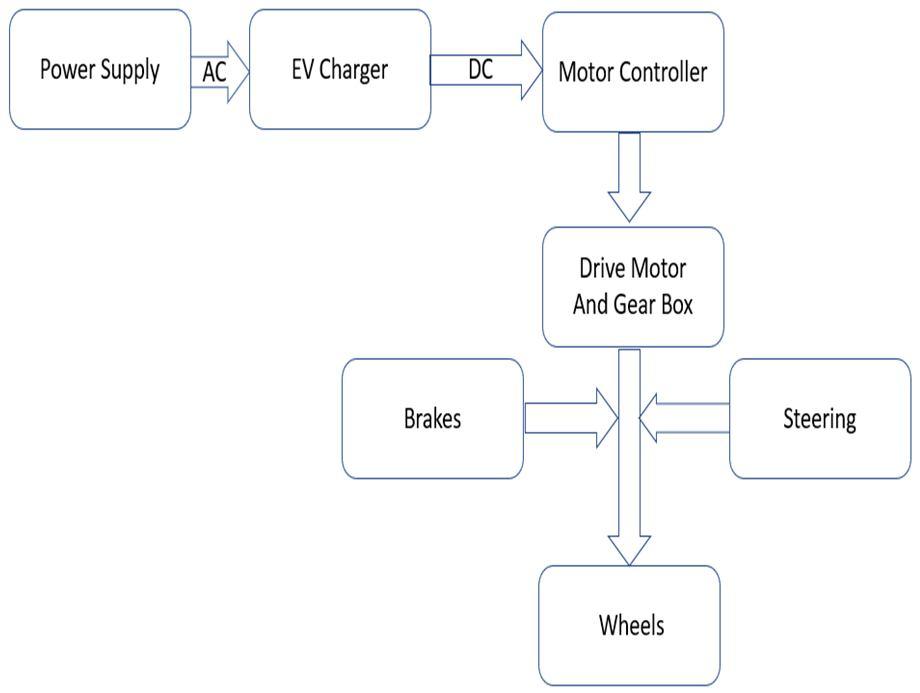
3 minute read
Design and Implementation of Electrical Car with Manual Gear System
1Assistant Professor, Department of EEE, Aditya Institute of Technology and Management, K.Kotturu, Tekkali 2, 3, 4, 5, 6UG Scholar, Department of EEE, Aditya Institute of Technology and Management, K. Kotturu, Tekkali
Abstract: This essay's main goal is to explain how to turn an outdated car with a petrol or diesel engine into an electric vehicle. An automobile is electric if its whole driving mechanism is an electric motor that is entirely powered by a battery pack. This car's unique characteristic is that it can be operated using the manual gearing system that the car already has.
Advertisement
Our goal is to demonstrate a low-cost method for converting ageing vehicles to electric vehicles. The primary obstacles in developing an electric car are selecting a motor that is rated appropriately for the vehicle, considering the passengers, battery pack, chassis, and motor weights. Another task is selecting a battery that meet our project's financial objectives. The use of several gear ratios provides several possible advantages, such as enhancing vehicle acceleration, gradeability, and top speed, and reducing the overall mass and space of the traction system. Due to their high torque and power requirements, performance vehicles, light to heavy duty trucks, and buses may particularly profit from multi-speed gearboxes.
Keywords: Permanent Magnet synchronous motor, Brush Less DC motor, manual gear box, rolling resistance, gradient resistance, aerodynamic resistance
I. INTRODUCTION
One of the best technologies for the future is the electric vehicle, which uses less fossil fuel and is more environmentally beneficial because it emits less dangerous pollutants. The charging module, converters, controllers, batteries, and electric motor are only a few of the numerous parts that make up an electric vehicle.
Figure 1 shows the block diagram of how power is distributed in an electric vehicle. The power supply can be obtained from domestic sources or from any charging stations, as shown in Figure 1. The battery is then given access to this power via an EV charger after it has been rectified using a converter. A motor controller aids in regulating the input and output characteristics of the motor, transfers electric power from the battery to the motor. With a drive shaft, the wheel receives the mechanical power the motor produces. In an electric car, mechanical power is created as a result of the electric current passing through various parts. As a result, the output parameters of a vehicle, such as its power, torque, speed, etc., are determined by an electric motor. In order to counteract the force caused by the load and other opposing forces operating on the vehicle, the electric motor chosen to drive it must be capable of producing enough power and torque. This paper deals with calculating the power rating required to drive an electric vehicle, and charging time of battery through an EV charger, along with its operation.
ISSN: 2321-9653; IC Value: 45.98; SJ Impact Factor: 7.538

Volume 11 Issue IV Apr 2023- Available at www.ijraset.com
II. SELECTIONOFMOTOROFSUITABLERATING
The force required for driving a vehicle is calculated below [1] – [4].
FT= Fr+ Fg+ Fa .(i)
Where, FT =Total force
Fr= force due to Rolling Resistance
Fg= force due to Gradient Resistance
Fa= force due to aerodynamic drag
F T is the total force that the output of motor must overcome, in order to move the vehicle.
A. Rolling Resistance
Rolling resistance is the resistance offered to the vehicle due to the contact of tires with road. The formula for calculating force due to rolling resistance is given by equation (ii):
Fr = Crr*M*g ……………
Where, Crr = coefficient of rolling resistance
M= mass in kg g= acceleration due to gravity = 9.81 m/s2
For the application considered, Crr =0.01
M= 800 kg
Then, Fr= 0.01*800*9.81=78.48 N
B. Gradient Resistance
………(ii)
Gradient resistance of the vehicle is the resistance offered to the vehicle while climbing a hill or flyover or while travelling in a downward slope. The angle between the ground and slope of the path is represented as α, which is shown in Figure 2.

The formula for calculating the gradient resistance is given by equation (iv):
Fg=M*g*sin α …………………………………………………………..(iv)
In this illustration, let us consider the electric car runs on a flat road. Therefore, the angle α =0⁰
Fg = 800*9.81*sin 0⁰ = 0 N……… .(v)
In this case, the power required to overcome gradient resistance is also zero.
C. Aerodynamic Drag
Aerodynamic drag is the resistive force offered due to viscous force acting on the vehicle. It is largely determined by the shape of the vehicle. The formula for calculating the aerodynamic drag is given by equation (vi):
Fa = 0.5*CA*Af *ρ*(V+Vo)2 …(vi)
Fa = [(0.5)*4.5*1.475*1.515* 1.23*(13.888+0) 2] = 92.66 N
These are the three main forces which act on the vehicle when it travels at constant speed. Therefore, the total tractive power required to move the vehicle is
FT= 78.48 N+ 0 N+92.66 N=171.14 N .(vii)
PT= 171.14*(50) *(1000/3600) = 2376.94 W


